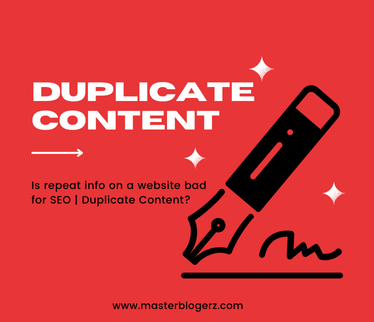
Table of Contents
Introduction

In the world of digital marketing, content is king. It’s the driving force behind search engine optimization (SEO), helping websites rank higher in search results, attract more visitors, and convert them into customers. However, not all content is created equal, and how it’s presented on your website can make a significant difference in your SEO performance. One issue that often arises is the repetition of information across various pages. But is this really bad for your website’s SEO?
Repeated information on a website can have both positive and negative impacts. While consistency in messaging is crucial, especially for branding and legal purposes, overusing the same content can lead to issues with search engine rankings. Understanding how repeated information affects SEO can help you create a website that’s both user-friendly and optimized for search engines.
Understanding Repeated Information
Definition: What Constitutes “Repeated Information” on a Website?
Repeated information, often referred to as duplicate content, occurs when the same blocks of text or very similar content appear on multiple pages of a website. This can happen for various reasons, from copying and pasting product descriptions to reusing service details across different pages.
Common Examples:
- Product Descriptions: In e-commerce, it’s common to see the same product description repeated across multiple pages, especially when the product has different variations.
- Service Details: Businesses that offer similar services might repeat the same service descriptions across various service-related pages.
- Company Information: About Us sections, company history, and mission statements are often repeated on different parts of the website.
- Boilerplate Text: Legal disclaimers, copyright information, and terms of service are typical examples of repeated content that appears on many pages.
While some repetition is necessary and unavoidable, it’s important to recognize when it might start to hurt your website’s SEO. In the following sections, we’ll explore the impact of repeated information on your site’s performance and how to manage it effectively.
The Impact of Repeated Information on SEO

In the world of SEO, content is king, but not all content is created equal. One of the challenges website owners face is managing repeated information across their site. While some repetition is inevitable, understanding how it impacts your site’s SEO is crucial.
Duplicate Content Penalty: How Search Engines Handle Repeated Information
When search engines like Google encounter repeated information on different pages of your website, they may treat it as duplicate content. Duplicate content refers to substantial blocks of content that appear on more than one URL, either on the same site or across different sites.
Search engines aim to provide the most relevant and unique content to users. When they find duplicate content, they have to decide which version to show in search results. This can dilute the visibility of your pages and lower your chances of ranking well. While Google doesn’t impose a strict penalty for duplicate content, it may affect your site’s performance by splitting link equity between the duplicates or, in some cases, not showing any of them.
Crawling and Indexing Issues: How Repeated Information Can Waste Crawl Budget
Search engines use bots, also known as crawlers, to discover and index content on your website. Each site has a crawl budget, which is the number of pages a search engine will crawl in a given period. If your website has a lot of repeated content, it can waste this valuable crawl budget.
When crawlers spend time indexing duplicate or repetitive information, they may overlook or delay indexing more important, unique content. This can result in slower updates to your site’s search listings and missed opportunities for ranking new or optimized content.
User Experience: The Effect of Repetitive Content on Engagement and Bounce Rates
User experience is a significant factor in SEO. When users visit your website, they expect to find useful, engaging, and original content. Repetitive information can frustrate users, leading to a poor experience. If visitors repeatedly encounter the same content across different pages, they may become disinterested and leave the site.
A high bounce rate, where users leave your site after viewing only one page, sends a signal to search engines that your site may not be providing the best user experience. This can negatively impact your rankings, as search engines strive to promote sites that satisfy user intent.
When Repeated Information is Necessary
While repeated information can be problematic, there are situations where it is necessary and even beneficial for your website. Knowing when and how to manage repetition is key to maintaining good SEO practices.
Brand Consistency: When Repetition is Required for Branding
Consistency is vital for brand recognition and trust. In some cases, repeating certain information across your website is necessary to maintain a consistent brand message. For instance, repeating your company’s mission statement or core values on various pages can reinforce your brand identity.
Similarly, product descriptions and service details may need to be repeated to ensure clarity and consistency across different sections of your site. In these instances, repetition supports your brand and provides a coherent experience for users.
Legal and Compliance Reasons: Necessary Repetitions
Certain types of information must be repeated across your website for legal or compliance reasons. This includes disclaimers, terms of service, privacy policies, and other legally mandated content. Repetition in these contexts is not only acceptable but required to meet legal obligations and protect your business.
In these situations, it’s important to ensure that the repeated information is up-to-date and consistent across all instances. Using canonical tags or noindex directives can help prevent these necessary repetitions from negatively impacting your SEO.
Best Practices for Handling Repeated Information
When it comes to managing a website, repeated information can sometimes feel inevitable. Whether it’s product descriptions, service details, or company information, certain content may need to appear in multiple places on your site. However, repeating information without careful consideration can lead to SEO challenges. Fortunately, there are best practices that can help you manage repeated content effectively, ensuring that your site remains both user-friendly and search engine optimized.
Canonical Tags: How to Use Canonical Tags to Manage Duplicate Content
Canonical tags are one of the most effective tools for managing duplicate content on your website. A canonical tag is a piece of HTML code that tells search engines which version of a page should be considered the “primary” version. This is particularly useful when you have similar or identical content across different URLs.
Example: Suppose you have two pages with similar content because they cater to different geographic regions. Without a canonical tag, search engines might see these as duplicate content and penalize your site. By adding a canonical tag to one of the pages, you can indicate to search engines that this page is the preferred version, helping to avoid any negative SEO impact.
Using canonical tags not only prevents duplicate content issues but also helps consolidate link equity, ensuring that all SEO benefits are directed to the primary page.
Content Differentiation: Strategies for Rewriting and Expanding on Repeated Information
While canonical tags are helpful, it’s often better to minimize repeated information by differentiating your content. Here are some strategies to help you do that:
- Rewriting Content: Instead of copying and pasting the same information across multiple pages, try rewriting the content in a unique way for each page. Focus on different aspects of the topic, use varied language, and tailor the content to the specific audience or context of each page.
- Expanding Content: If you find that certain information needs to be repeated, consider expanding on it. Add more details, examples, or related information that enriches the content and provides additional value to the reader. This not only reduces the risk of duplicate content but also enhances the user experience.
- Segmenting Content: Break down the repeated information into smaller segments and distribute them across various sections of your site. For example, instead of having a lengthy product description repeated on several pages, create dedicated pages for different product features or benefits.
Internal Linking: Using Internal Links to Avoid Unnecessary Repetition
Internal linking is another powerful strategy to manage repeated content. By strategically linking to relevant pages within your website, you can guide users to the information they need without having to repeat the content verbatim on multiple pages.
Example: If you have a detailed article about a specific service, rather than summarizing it on multiple pages, you can create a short introduction and link to the full article. This not only helps to avoid content repetition but also improves the overall navigation of your website, making it easier for users to find relevant information.
Internal links also help search engines understand the structure of your site and the relationships between different pages. This can improve the crawlability of your site and enhance your SEO efforts.
Case Studies
To understand how these best practices work in real life, let’s look at two case studies—one positive and one negative—regarding the handling of repeated content.
Positive Example: A Case Where Repetition Was Managed Effectively Without Harming SEO
A popular e-commerce site faced challenges with repeated product descriptions across multiple category pages. Instead of risking duplicate content penalties, they implemented canonical tags on pages where duplication was unavoidable. For other pages, they focused on rewriting and expanding the content, ensuring that each page offered unique value to users. Additionally, they used internal linking to guide users to detailed product descriptions, rather than repeating the same information on every page.
As a result, the site maintained its strong search engine rankings and provided a better user experience, with clear navigation and diverse content across the site.
Negative Example: A Scenario Where Repeated Content Led to SEO Issues
A small business website struggled with repeated service descriptions across several landing pages. They neglected to use canonical tags and didn’t differentiate the content, resulting in nearly identical pages. This led to a decrease in search engine rankings as Google flagged the site for duplicate content. The site’s traffic dropped, and users found the repetitive content frustrating, leading to higher bounce rates.
After recognizing the issue, the business took steps to rewrite the content and implement canonical tags where necessary. Although it took time to recover, the site eventually regained its rankings by following best practices.
Tools to Identify and Manage Repeated Content
Managing repeated content on your website is crucial for maintaining a healthy SEO profile. Thankfully, there are several tools available that can help you identify and manage duplicate content effectively. Let’s take a look at some of the most popular SEO audit tools and CMS plugins that can assist you in this process.
SEO Audit Tools: Brief Overview of SEMrush, Ahrefs, and Screaming Frog
1. SEMrush: SEMrush is a powerful SEO tool that offers a comprehensive site audit feature. It scans your website for various issues, including duplicate content. SEMrush highlights pages with repeated information, allowing you to address these issues promptly. The tool also provides insights into how duplicate content might affect your SEO, offering suggestions for improvement.
2. Ahrefs: Ahrefs is another popular SEO tool that includes a site audit feature. It identifies duplicate content by scanning your website and flagging any pages with similar or identical content. Ahrefs also provides detailed reports on your website’s overall health, helping you prioritize and fix duplicate content issues that might be harming your SEO efforts.
3. Screaming Frog: Screaming Frog is a versatile SEO spider tool that crawls your website and detects duplicate content among other SEO-related issues. This tool is particularly useful for large websites with thousands of pages, as it allows you to export detailed reports and analyze your content more effectively. Screaming Frog’s easy-to-use interface makes it a favorite among SEO professionals.
Content Management Systems (CMS): How CMS Plugins Can Help Manage Duplicate Content
Content Management Systems (CMS) like WordPress, Joomla, and Drupal offer plugins that can help manage duplicate content on your website. These plugins are designed to make it easier for you to maintain a clean and SEO-friendly site without much manual effort.
1. Yoast SEO (WordPress): Yoast SEO is one of the most popular SEO plugins for WordPress. It includes a feature that helps manage duplicate content by allowing you to set canonical URLs. Canonical URLs tell search engines which version of a page is the preferred one, helping to avoid duplicate content issues. Yoast also provides content analysis tools that alert you if your content is too similar to other pages on your site.
2. All in One SEO Pack (WordPress): Similar to Yoast SEO, the All in One SEO Pack plugin offers features to help manage duplicate content. It allows you to set canonical URLs and provides SEO recommendations to improve your site’s performance. This plugin is user-friendly and integrates well with other WordPress plugins, making it a reliable choice for managing your website’s content.
3. Duplicate Content Checker (Joomla): For Joomla users, the Duplicate Content Checker plugin is an excellent tool to identify and manage duplicate content. It scans your website for repeated information and provides reports that you can use to make necessary adjustments. This plugin helps ensure that your site remains SEO-friendly by minimizing the risk of duplicate content penalties.
Conclusion
Summary: Recap the Main Points
Managing repeated content on your website is essential for maintaining good SEO health. Tools like SEMrush, Ahrefs, and Screaming Frog offer comprehensive site audits to help identify duplicate content issues. Additionally, CMS plugins such as Yoast SEO and All in One SEO Pack provide practical solutions for managing and avoiding duplicate content, ensuring that your site remains optimized and user-friendly.
Final Thoughts: Balancing Repetition with Content Uniqueness
While it’s important to avoid unnecessary repetition, there are instances where repeated information is necessary for branding or legal reasons. The key is to balance repetition with content uniqueness, ensuring that your website provides valuable and original content to users while adhering to SEO best practices. By using the right tools and strategies, you can effectively manage duplicate content and maintain a strong online presence.
FAQs
1. Is repeated content always bad for SEO?
No, repeated content is not always bad for SEO. There are situations where repetition is necessary, such as for legal disclaimers or consistent branding. However, excessive repetition without differentiation can lead to SEO issues like duplicate content penalties and poor user experience.
2. How can I identify repeated content on my website?
You can identify repeated content on your website by using SEO audit tools like SEMrush, Ahrefs, and Screaming Frog. These tools scan your site and flag pages with similar or identical content, allowing you to address the issues accordingly.
3. What should I do if I have to repeat information?
If you must repeat information on your website, consider using canonical URLs to indicate the preferred version of the content to search engines. Additionally, try to differentiate the repeated content by adding unique insights, examples, or expanding on the information to provide added value to your users.

Aitizaz Rahim is a dynamic Digital Marketing and SEO expert, empowering businesses worldwide with proven strategies. As the founder of Masterblogerz, he shares actionable insights to help others master the digital marketing world.




One Comment